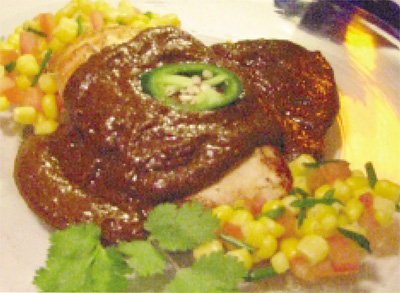 In Mérida, Mexico, the summers are grueling. Even the iguanas — the Yucatan’s version of pigeons — scramble to get away from the heat of the July afternoon. Bedded down for the afternoon siesta in a rooftop hammock, I was the guest of Señora Inel Alcocer, residing with my abuelita (little grandmother) for a summer in a pink stucco house that had been battered by its share of hurricanes. Life was good.
In Mérida, Mexico, the summers are grueling. Even the iguanas — the Yucatan’s version of pigeons — scramble to get away from the heat of the July afternoon. Bedded down for the afternoon siesta in a rooftop hammock, I was the guest of Señora Inel Alcocer, residing with my abuelita (little grandmother) for a summer in a pink stucco house that had been battered by its share of hurricanes. Life was good.
On that particular afternoon, there were very few things that could have pried me from my hammock. Then the smell hit me and I was up in an instant: mole. When Señora Alcocer cooked mole (pronounced MO-lay), I often felt like a cartoon character, floating in a dreamlike state above the ground as the visible wisps magnetically drew me to the source.
There might not be a more quintessentially Mexican food than mole. This traditionally thick, dark sauce is shrouded in legend and mystery, from its ingredients to its origins. With rich flavors that are steeped in complexity, mole is one of those rare foods that can offer the palate a completely different experience with each bite.
Most people agree that mole can be traced to a convent in the state of Puebla in the late 1600s, and though accounts of the exact origins differ, a nun by the name of Sister Andrea is said to be its creator. Some say a strong wind blew some leftover spices out the window and onto the plates of banquet guests, while others describe a last-minute dish thrown together for a visiting archbishop from Spain.
Mexico is as much a melting pot as the United States. For hundreds of years, European colonists and occupiers clashed with indigenous populations such as the Maya and Aztec, and the majority of Mexicans today are something of a mixture, or Mestizo. Where ethnicity blended, Mexican cultural signifiers such as art and music followed suit throughout the revolution-torn first part of the 20th century, and cuisine was no exception.
Mole itself is derived in part from the Aztec recipe for chocolate, with the basic ingredients being roasted cacao beans flavored with chili peppers. The word comes from the Aztec word molli, or sauce. Mirroring Mexico’s rich cultural heritage, it is still made from a mixture of pre-Columbian spices and European flavors. Ingredients can include pumpkin seeds, cinnamon, raisins, oregano, and ancho chili peppers. The sauce is commonly served with poultry or enchiladas, though variations abound.
Looking back, it never seemed like Señora Alcocer was ever really working that hard when making her magical mole. It all just came together. I’m a few years older now, and I even know my way around the kitchen, yet cooking the perfect mole is one of those pinnacles I never expect to reach. That particular summer, mole was the perfect dish; when I paid close attention, I could taste the fabric of Mexico itself. And who knows, if it weren’t for Señora Alcocer’s mole, I might still be in that hammock.
Marshall Leroy Smith grew up in the southwestern United States and has traveled in Mexico throughout his life. Concentrating on Latin American studies at the University of Texas, he earned a master’s degree in journalism, focusing on media representation of the Zapatistas, in Chiapas. He was also a sous chef in Austin. Smith is the Museum’s public relations assistant and a writer.
